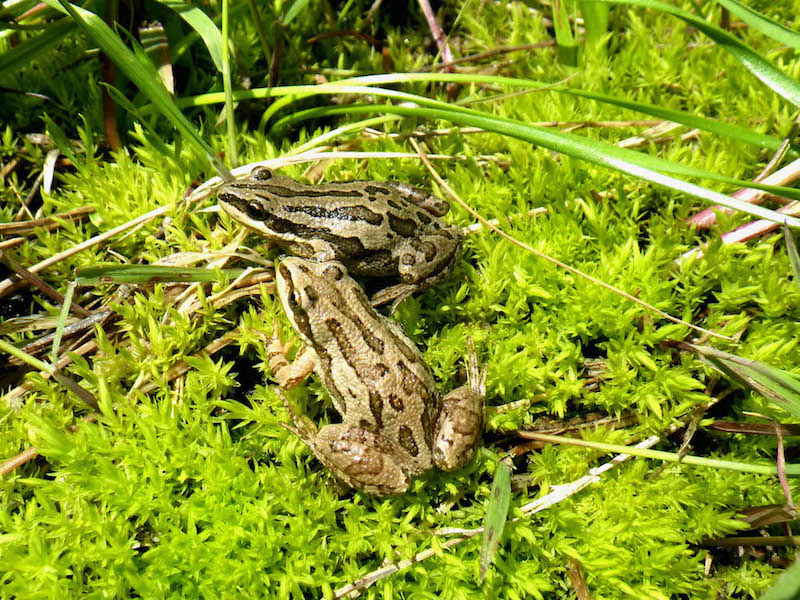By Debra Patla – Research Associate, Northern Rockies Conservation Cooperative
If you see or hear an amphibian this month, wish it “Good Night and Good Luck!” Amphibians (frogs, toads, and salamanders) mostly vanish from our view in September and are not seen again until April or May. Where do they go? How do these small, fur-less animals not only survive Jackson Hole winters, but also manage to do so for long lives of up to 15 years or more?
As ectotherms (“cold-blooded” vertebrates), amphibians have the advantage of being able to go for months without any food at all. The popular idea that they just go down into the mud to sleep for the winter does not actually pertain to any of our locals. Each species here has its own special adaptations, and these are so successful that we see some populations persisting over decades, showing up to breed in the same wetlands every spring. The basic recipe is being able to get to the right places in late summer/fall, which typically means dispersing or migrating. This crucial element of their lives makes amphibians very vulnerable to development, landscape alteration, and roads, even if wetlands are protected.
Jackson Hole has four species of native amphibians. Here are their winter-survival recipes:
Boreal Chorus Frog: Find a good dry place and chill!
Boreal Chorus Frogs over-winter terrestrially (not in water) — at or near the soil surface, such as under rocks and logs, in leaf litter and loose soil under snow, among tree roots, and in animal burrows. Some of these frogs may even find a place in your basement, house foundation, or out-building, if they have survived the trip to your yard from the pond where they metamorphosed from tadpoles or mated as adults.
The miracle ingredient of their strategy is that chorus frogs can tolerate freezing. Only a few species of amphibians in North America can do this. Physiological adaptations allow them to stop breathing, heartbeat, and blood flow, while the water outside their cells and vital organs freezes. Then they thaw out and make the trek to a wetland where you will again hear their amazing concerts in the spring.
By the way, you may hear this species in October: they sometimes make a small trill in fall during the daytime, usually from dry places within a few hundred yards of a pond. This sound is much shorter and softer than their breeding call and is a bit like the softest clacking call of a Clark’s Nutcracker (but on the ground). No one seems to know why they do this!
Columbia Spotted Frog: Find water that does not freeze, with oxygen please!
Columbia Spotted Frogs spend the winter in spring-fed streams, ponds or lakes with springs or upwelling water, submerged bank chambers at the edges of water bodies, and in underground springs. Do they sleep all winter? No, studies indicate they often move around in their winter areas to find more oxygen or warmer water. Spotted frogs often aggregate at winter sites, a kind of party we can only try to imagine! But the tendency to gather at crucially important, hard (for us)-to-recognize sites threatens our ability to conserve local population of this species.
Western Toad: Find a cozy underground nook!
Western Toads exhibit yet another winter strategy: they cannot tolerate freezing, but they do not over-winter in water like spotted frogs. Toads seek out rodent burrows, squirrel middens, crevices or chambers underground, decayed root tunnels of large trees, or abandoned beaver lodges. What’s important is to get away from the frost zone. Toads may migrate long distances (e.g., over 1 mile) to reach their over-winter sites, and they spend the winter communally, suggesting that suitable sites are quite rare in the landscape. These behaviors pose a big challenge to successful conservation of local populations.
Western Tiger Salamander: Just go deeper!
Adult Western Tiger Salamanders spend most of their lives underground even in summer in rodent burrows (such as those made by pocket gophers) or under logs or rocks. They can also dig their own burrows in soft soil. Winter dictates that they get away from the frost zone and the danger of freezing by going deeper down in the underground. Their behavior is hard for modern researchers to investigate because they do not carry radio transmitters well on their long slender bodies, and implanted transmitters do not work underground.
Tiger salamanders are Jackson Hole’s ‘Trickster’– they have a knack of showing up and surprising people in yards, cellars, garages, dog water bowls, under buckets and porches, window wells, irrigation ditches, fish hatchery runways — good grief, what’s next? There are quite a few observations of large numbers of salamanders crossing roads, usually at night, in the rain. This again shows how vulnerable amphibians are to habitat fragmentation and increasing traffic in the face of their vital need to find safe winter places.

Boreal Chorus Frogs over-winter out of the water near the ground surface. Photo Credit: Jaime Hazard.
Deb Patla is a herpetologist who lives near Moran in Buffalo Valley. She has conducted long-standing amphibian surveys in Grand Teton and Yellowstone National Parks as well as the National Elk Refuge. She is also a Nature Mapper and vets our amphibian and snake observations. Please keep on mapping those creeping, leaping, and slithering creatures!
